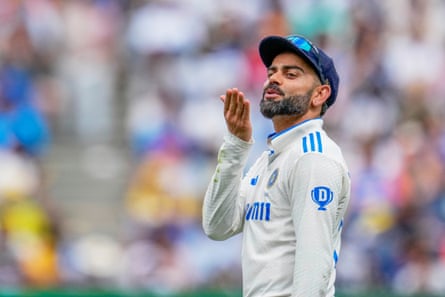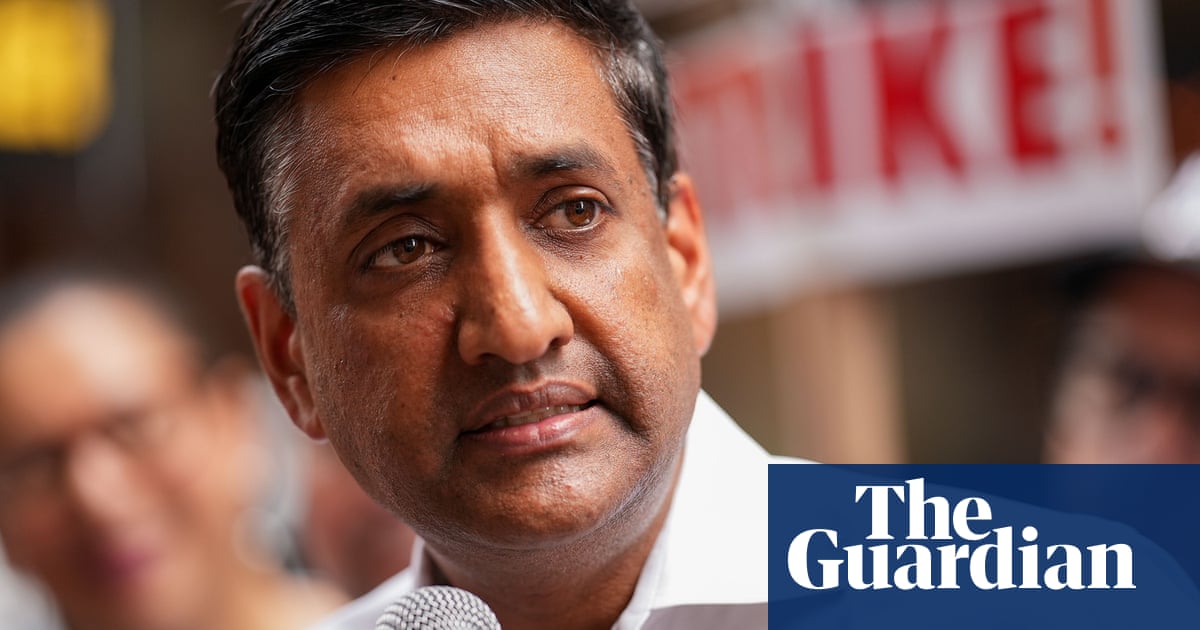At dawn on a pale pastel morning in late January, thousands of fans started queueing outside the Arun Jaitley Stadium in Delhi. Before long the queues turned chaotic. Scuffles broke out. Three people were injured and a police motorcycle was damaged. Armed security personnel were deployed inside and outside the venue, occasionally stepping in front of the sightscreen and causing play to be stopped.
But the consequences of Virat Kohli playing his first domestic red-ball game for Delhi in 12 years are less interesting than why he was there in the first place. Kohli rolled up in his Porsche two days before the game, arriving early to beat the crowds and so he could fit in a full gym session before team fitness drills and net practice. Desperately short of form, and yet a desperate romantic, Kohli had come to worship at the altar. One last crack at Test cricket. One last attempt at rekindling the skill that had long deserted him.
As it turned out, Delhi v Railways would be Kohli’s last red‑ball innings. He was bowled for six and Delhi won by an innings, so that was it, apart from the spectator who invaded the field to touch his feet. And as he announced his retirement from Test cricket on Monday, somehow the strongest memory was not of the 149 at Edgbaston or the 169 at Melbourne or the 254 at Pune, the times when he would make cricket look scandalously easy.
What lingers, by contrast, is the times when it was scandalously hard: when the bowlers were fresh and the pitch was spicy and the verbals were flowing, and he pushed through anyway, because this game is a sacred birthright and you will never truly conquer it, but the only glory is in trying. “I cannot explain the job satisfaction you get when you do well in Test cricket,” Kohli once said in an interview with Wisden Cricket Monthly. But what he could not explain in word, he more than conveyed in deed.
Kohli kept getting out to Jimmy Anderson in 2014. Before his next tour of England four years later, he buried himself in video footage and net practice: realigning his hips, his footwork, his shoulders, seeking out old coaches for advice, even installing a camera alongside the crease so he could monitor his foot position. Frankly, Test cricket should be exactly this hard, exactly this obsessive, exactly this painstaking, exactly this exacting. This is the only way it makes sense.
Kohli made 593 runs in that 2018 series, the centrepiece of a purple patch that lasted from late-2014 to the pandemic, during which he seemed to be batting with a kind of force field around him. He scored centuries on every continent, against every team he faced. And of course it never had to be this way. Early in his career Kohli was pegged as a white-ball specialist who would never sufficiently harness his hot-blooded temperament to succeed in the five-day game.

There were occasional unflattering comparisons with Michael Bevan. Though it seems strange to recall now, there was a feverish element of superimposed crisis to the early years of Kohli’s career, the first imperial bloom of the Indian Premier League. The deeply fusty idea that the older generation – Sachin Tendulkar, Rahul Dravid, Sourav Ganguly, Anil Kumble – had treasured this game, and now the flash kids with their tattoos and haircuts were going to ruin it by turning it into an obstacle course or a Gangnam Style or something.
Neither market forces nor physical wellbeing dictated that Kohli had to dominate Test cricket. He could easily have quiet-quit like Jos Buttler or Mahendra Singh Dhoni, made his legend and made his fortune. But something about this game beguiled him, bewitched him, wound him closer. And ultimately Kohli would advocate for Test cricket not just through words and not just through deeds, but by a kind of exemplary fury: a face and an energy and an intensity that through its sheer force of will ennobled the contest itself.
Whether through fielding standards or fitness, petulance or belligerence, Kohli did not just want to beat you. He wanted to bury you. He wanted you to cry about it. “The most Australian non-Australian cricketer we’ve ever seen,” was Greg Chappell’s verdict on Monday, and it speaks volumes about Kohli that his average against Australia away is higher than it was at home. Something about those tours – the sledging, the crowd abuse, the heat and the light and the hostility – seemed to summon the animal in him.
Eight years ago, on a white-ball tour of India, I was exercising in a hotel gym in Nagpur when in walked pretty much the last person you want to be exercising alongside in a hotel gym in Nagpur. And of course Kohli was the perfect physical specimen, emasculatingly so, a man who could lift more with his left arm than I could with both. But the bit that sticks was when Kohli noticed that the Australian Open final between Roger Federer and Rafael Nadal was reaching a crucial juncture.
after newsletter promotion
Kohli strode right up to the TV until the screen was about four inches from his face. For the rest of the set his veins bulged, he shook his fist, he shouted encouragement. For years I had assumed the famed Kohli intensity was a kind of public persona, a superhero costume he could slip off as soon as the day was done. This was the moment the penny dropped. Oh wow. It is not an act. He is actually just like this all the time. And so my abiding Kohli memory is not an innings, or a series, but the sight of him screaming “COME ON ROGER! YES ROGER! LET’S GO! YES!” in a hotel gym in Nagpur to an audience of one.

It matters, too, that Kohli excelled in all three formats, that he did so as a classically orthodox player, all timing and training. Kohli described Test cricket as the most beautiful format of all, but he loved them all, and wherever he went he took his board, his teammates, his fans and the eyeballs of the world with him. He teaches us, perhaps, that amid the tribalism and format warfare, this is all basically cricket, the same base material we all know and love. The only reliable way of securing a legacy was to master all of it.
The finances of the game are still grossly unequal. The smaller nations still need more support. Kohli always resisted the idea that one man could sustain Test cricket by exemplar alone, always urged national boards to invest in red-ball cricket, always argued that the dominance of Twenty20 was not simply a question of finance but of standards, facilities and basic respect. In this respect he may well end up being the most consequential cricketer of his age.
The retirement of Kohli, and Rohit Sharma and Tim Southee and Anderson before him, will be greeted inevitably with heralds of doom. Test cricket’s existential crisis will never pass. In many ways the existential crisis is baked into the product, a form of sport that comes with its own in-built sense of decline. But the torch will pass: to Shubman Gill and Rishabh Pant, to Yashasvi Jaiswal and Vaibhav Suryavanshi, the teenage prodigy who already has a century in whites for India under-19s. All will tread a path Kohli blazed: the idea of cricket as a cogent whole, each part as important as the next. Kohli believed in Test cricket until it broke him. Now, more than ever, is the time to show the same faith.

 1 month ago
73
1 month ago
73

















































